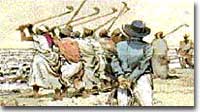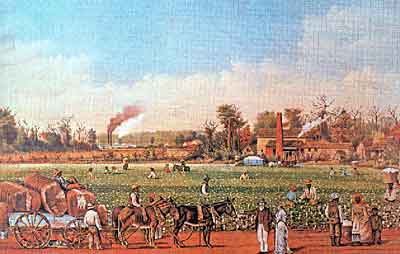6d. Slave Life on the Farm and in the Town
In the first decades of European settlement in America, the physical labor of establishing homes, agriculture, and commerce was carried out by "bound" laborers—that is unpaid workers who were owned by ("bound" to) a "master" who controlled not only their labor, but also all other aspects of their lives. These workers were "indentured servants" from Europe, who were freed after some years of service, or indigenous native Americans (who often knew how to escape into areas where European "masters" could not find them), or by laborers bought in Africa and stranded in America, unable to return to their homes, and easily identifiable by their dark skins. Sometimes African workers were treated like indentured servants, and freed after some years of service. But after 1690, the status of slavery hardened: bound labor, based on race, became a lifetime sentence, inherited from generation to generation.

Enslaved people on Southern plantations worked a variety of tasks and performed many kinds of labor.
What was it like to live in bondage? The experiences of enslaved people varied somewhat, depending upon region and the local economy. Sometimes, the type of life an enslaved person could expect depended on whether they lived on farms or in towns—and on the temperament or mood of their masters.
Often, the first image that comes to mind when considering slavery is the image of the large plantation, where the cultivation of the planter's crop was the first priority. Beyond these duties, enslaved people's skills might be used to clear land, design and construct houses or fences, to breed and tend livestock, to create and tend gardens, craft medicines from local plants, or other jobs as particular circumstances might dictate. White overseers might be assigned to monitor the work. Overseers had less economic investment in the slave, and the enslaved people often bore the brunt of an overseer's resentment of the master's wealth, power, and privilege. Sometimes an enslaved person, called a "driver," would be enticed into holding this position. Not surprisingly, both overseers and drivers were often disliked by the people they controlled. On large plantations, enslaved people's living quarters were often set at some distance from the master's house. These "slave quarters" as they were called, were small and spartan, and—unless the residents kept their own gardens or made their own clothing—food and clothing were often sparse and of low quality.
Large plantations might also have a few enslaved people living and/or working inside the masters' houses. These domestic servants might prepare the master's meals, repair or tend the house, make or repair clothing, prepare for guests, and often care for the masters' children. Though in some cases these "house slaves" were considered part of the extended family, they could not forget that they were property, with no protection from being mistreated, beaten, or sold.

This painting shows enslaved people picking cotton on a Mississippi plantation. Youngsters would begin carrying water at the age of 5 or 6.
However, at the height of the slave era (1830–1860), only a few thousand masters owned as many as 300 people. Most rural enslaved people were owned by masters who had 10–20 enslaved people, who often were housed in closer proximity to masters, perhaps sharing housing, and perhaps having access to closer relations with their masters than plantation slaves had. Sometimes—but not always—this housing arrangement could lead to kinder treatment. Sometimes, too, this closeness could open opportunities for black laborers to purchase their own freedom, or the freedom of their wives—a great advantage, since a child born to a free mother was automatically free.
Some urban merchants and artisans employed slave labor in their shops. This enabled enslaved people to ply the craft skills they brought with them, as well as to acquire skills that were marketable in their new environment. In that setting, however, enslaved workers sometimes encountered the resentment of white craftsmen who felt displaced. Generally, enslaved people who lived in towns had greater freedom than those who lived on farms. They could become more aware of opportunities for escape, and they could form a more diverse community with other people of African descent who were enslaved or who were free. Daring (or desperate) individuals—in both rural and urban settings—sometimes used such connections to seize the opportunity for escape.






